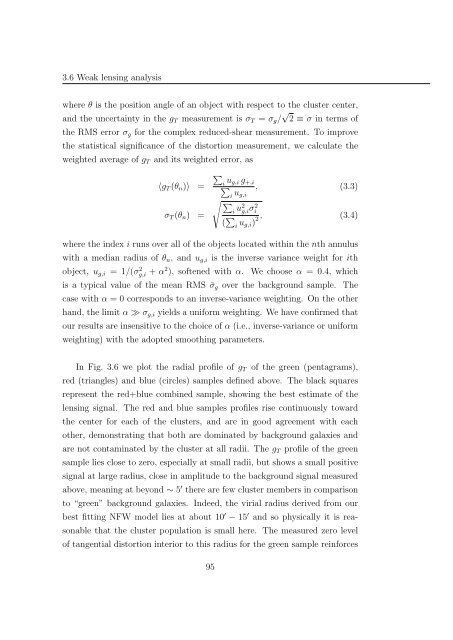Mass and Light distributions in Clusters of Galaxies - Henry A ...
Mass and Light distributions in Clusters of Galaxies - Henry A ...
Mass and Light distributions in Clusters of Galaxies - Henry A ...
You also want an ePaper? Increase the reach of your titles
YUMPU automatically turns print PDFs into web optimized ePapers that Google loves.
3.6 Weak lens<strong>in</strong>g analysis<br />
where θ is the position angle <strong>of</strong> an object with respect to the cluster center,<br />
<strong>and</strong> the uncerta<strong>in</strong>ty <strong>in</strong> the g T measurement is σ T = σ g / √ 2 ≡ σ <strong>in</strong> terms <strong>of</strong><br />
the RMS error σ g for the complex reduced-shear measurement. To improve<br />
the statistical significance <strong>of</strong> the distortion measurement, we calculate the<br />
weighted average <strong>of</strong> g T <strong>and</strong> its weighted error, as<br />
∑<br />
i<br />
〈g T (θ n )〉 =<br />
u g,i g<br />
∑ +,i<br />
, (3.3)<br />
i u g,i<br />
σ T (θ n ) =<br />
√ ∑<br />
i u2 g,i σ2 i<br />
( ∑ i u g,i) 2 , (3.4)<br />
where the <strong>in</strong>dex i runs over all <strong>of</strong> the objects located with<strong>in</strong> the nth annulus<br />
with a median radius <strong>of</strong> θ n , <strong>and</strong> u g,i is the <strong>in</strong>verse variance weight for ith<br />
object, u g,i = 1/(σg,i 2 + α 2 ), s<strong>of</strong>tened with α. We choose α = 0.4, which<br />
is a typical value <strong>of</strong> the mean RMS ¯σ g over the background sample. The<br />
case with α = 0 corresponds to an <strong>in</strong>verse-variance weight<strong>in</strong>g. On the other<br />
h<strong>and</strong>, the limit α ≫ σ g,i yields a uniform weight<strong>in</strong>g. We have confirmed that<br />
our results are <strong>in</strong>sensitive to the choice <strong>of</strong> α (i.e., <strong>in</strong>verse-variance or uniform<br />
weight<strong>in</strong>g) with the adopted smooth<strong>in</strong>g parameters.<br />
In Fig. 3.6 we plot the radial pr<strong>of</strong>ile <strong>of</strong> g T <strong>of</strong> the green (pentagrams),<br />
red (triangles) <strong>and</strong> blue (circles) samples def<strong>in</strong>ed above. The black squares<br />
represent the red+blue comb<strong>in</strong>ed sample, show<strong>in</strong>g the best estimate <strong>of</strong> the<br />
lens<strong>in</strong>g signal. The red <strong>and</strong> blue samples pr<strong>of</strong>iles rise cont<strong>in</strong>uously toward<br />
the center for each <strong>of</strong> the clusters, <strong>and</strong> are <strong>in</strong> good agreement with each<br />
other, demonstrat<strong>in</strong>g that both are dom<strong>in</strong>ated by background galaxies <strong>and</strong><br />
are not contam<strong>in</strong>ated by the cluster at all radii. The g T pr<strong>of</strong>ile <strong>of</strong> the green<br />
sample lies close to zero, especially at small radii, but shows a small positive<br />
signal at large radius, close <strong>in</strong> amplitude to the background signal measured<br />
above, mean<strong>in</strong>g at beyond ∼ 5 ′ there are few cluster members <strong>in</strong> comparison<br />
to “green” background galaxies. Indeed, the virial radius derived from our<br />
best fitt<strong>in</strong>g NFW model lies at about 10 ′ − 15 ′ <strong>and</strong> so physically it is reasonable<br />
that the cluster population is small here. The measured zero level<br />
<strong>of</strong> tangential distortion <strong>in</strong>terior to this radius for the green sample re<strong>in</strong>forces<br />
95
















